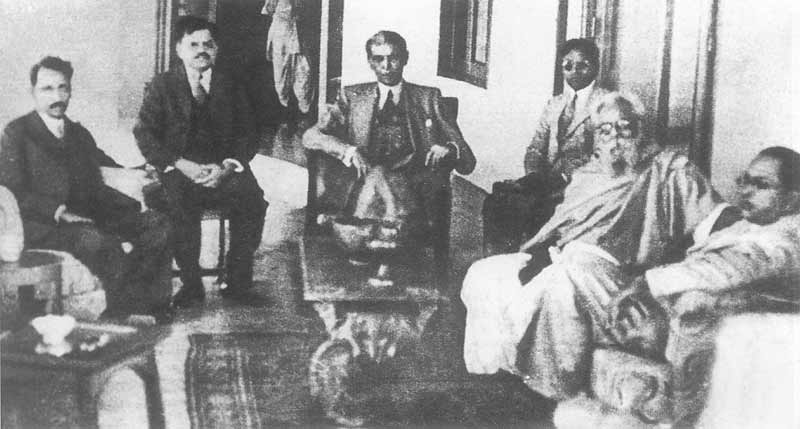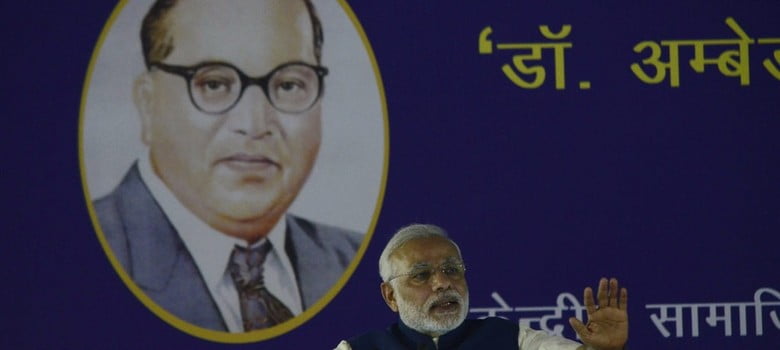
The popularity of Bhimrao Ambedkar in 2016 is remarkable.
Ambedkar was always a Dalit icon. On his birth and death anniversaries, his memorial in Mumbai draws huge crowds that are much larger than those at memorials of any other Raj-era political leader, including Mahatma Gandhi. But what is remarkable is how mainstream political parties like the Bharatiya Janata Party and the Congress have scrambled to honour the architect of the Indian Constitution ahead of his 125th birth anniversary on April 14. Both parties had, last year, announced year-long celebrations in the run up to this day in an apparent bid to claim his legacy. And as the anniversary draws closer, the government is firming up plans for a nationwide commemoration.
These bids to claim the legacy of the Dalit icon continue even as reports of Dalit oppression emerge from across the country with disturbing regularity.
Political icon
Ambedkar’s installation as a mainstream political icon is quite recent. Kancha Illaiah, academic and thinker on Dalit issues, says:
“Until 1990, Ambedkar was untouchable to all mainstream political parties. The question of the BJP looking at him did not arise at that time. The implementation of the Mandal Commission report, the VP Singh government honouring Ambedkar with the Bharat Ratna and the massive Dalit civil societal celebration of his role across the country triggered a new debate. From 1991 to 2015, emerging civil societal forces acquired definite intellectual status in universities and colleges and became a force to reckon with.”
Ambedkar is today a national icon. However, during his lifetime, he actually had very little to do either with the Congress or the Hindu right wing that later coalesced into the Bharatiya Janata Party.
Mutual antipathy
As is well known, Ambedkar blamed Gandhi for suppressing the Dalit political voice. In 1955, Ambedkar angrily told the British Broadcasting Corporation that Gandhi did not deserve the title of Mahatma, “not even from the point of view of his morality”.
Ambedkar signed the 1932 Poona pact – as per which Dalit representatives would not be elected by a separate Dalit electorate but by all castes – after Gandhi went on a hunger fast. The pact is so seminal in the Dalit movement that the late Kanshi Ram, the founder of the Bahujan Samaj Party, called his book on the Congress party’s Dalit politics post that pactThe Chamcha Age.
Gandhi was wary of Ambedkar too. He wrote to Vallabhbhai Patel a year before Independence:
“The main problem is about Ambedkar. I see a risk in coming to any sort of understanding with him, for he has told me in so many words that for him there is no distinction between truth or untruth or between violence and non-violence. He follows one single principle, viz. to adopt any means which will serve his purpose. One has to be very careful indeed when dealing with a man who would become a Christian, a Muslim or Sikh and then be reconverted according to his convenience. There is much more I could write in the same strain”
Proud identity
Given his politics that revolved around a proud Dalit identity, Ambedkar naturally came into conflict with the Hindu right. In the run up to the Poona Pact, Ambedkar favoured separate electorates for Dalits to exclusively vote for Dalit representatives. But the Hindu Mahasabha signed a deal with a prominent Dalit leader of the time, MC Rajah, to accept joint electorates where caste Hindus and Dalits would vote together (i.e. the current system). Rajah, who compromised with the right wing, is now a forgotten figure.
Vallabhbhai Patel too disliked Ambedkar’s politics, accusing him in 1948 of wanting to divide the country. In the Constituent Assembly, as Ambedkar tried to move an amendment to grant Dalits greater electoral rights, Patel opposed it, and attacked him:
“Let us forget what Dr Ambedkar has done. Let us forget what you [Nagappa, another Dalit Assembly member and an Ambedkarite] did. You have very nearly escaped partition of the country again on your lines. You have seen the result of separate electorates in Bombay, that when the greatest benefactor of your community [referring to Gandhi] came to Bombay to stay in bhangi quarters it was your people who tried to stone his quarters. What was it? It was again the result of this poison, and therefore I resist this only because I feel that the vast majority of the Hindu population wish you well. Without them where will you be? Therefore, secure their confidence and forget that you are a Scheduled Caste.”
The most hated man in India
Patel wasn’t alone in his dislike of Ambedkar’s politics. Dhananjay Keer, Ambedkar biographer, wrote that after opposing Gandhi on the Poona Pact, Ambedkar became widely unpopular across India:
“Ambedkar now became the most hated man in India. He was stigmatised as an uncivil, insolent, inordinately rude man, devoid of human consideration. He was represented as a devil, was cursed as a public nuisance number one and was dammed as a reactionary, a stooge of the British government, a traitor to the country and a destroyer of Hinduism.”
Arun Shourie, prominent right-wing intellectual and minister in the Vajpayee government, repeated the “Ambedkar is a traitor” trope in his book, Worshipping False Gods. In the book, Shourie states:
“There is not one instance, not one single, solitary instance in which Ambedkar participated in any activity connected with the struggle to free the country”.
Ambedkar was hated because he took bold positions and did not care for the upper-caste dominated mainstream of Indian politics. He often cooperated with the establishment – with the British during the Raj, and with the Congress after Independence. Political scientist Christophe Jaffrelot points out that Ambedkar was supremely practical and did whatever it took to help his community. Thus, in 1939, he tied-up with the Muslim League and Jinnah to mark a “Day of Deliverance” in order to celebrate the mass resignation of all Congress ministries to protest India’s entry into World War II.

Allying with the Socialists
In 1951, Ambedkar’s attempts to modernise Hindu personal law met with strong opposition from the Hindu right. One of them was SP Mookerjee, the founder of the Bharatiya Jana Sangh, the precursor to the Bharatiya Janata Party, who felt these new laws, which promised gender equality, were instruments that would “shatter the magnificent structure of Hindu culture”.
Frustrated with this Opposition, Ambedkar resigned as law minister from Nehru’s cabinet and allied with the Socialist Party to fight the 1951 general elections. Even during this campaign, Ambedkar went against the mainstream, promising his Muslim constituents that he would fight for separate electorates for them, just as he had for Dalits.
As a further measure of his protest, he converted to Buddhism in 1956, an event that the Bharatiya Janata Party glosses over given its strong opposition to conversion.
Bahujan politics and Ambedkar
Thus, Ambedkar is lionised today, but not for any of the principles he stood for during his lifetime.
His new-found popularity among mainstream political parties can be attributed to the rise of Ambedkarite politics, which uses the Dalit identity to vie for political, economic and social power.
It started with the formation, in 1978, of the All India Backward and Minority Communities Employees Federation, known as BAMCEF, an organisation of mainly Dalit public sector employees. This later led to the establishment of the Bahujan Samaj Party, which changed Indian politics forever by creating an independent Dalit leadership.
Mainstream political parties now have to woo Dalits, a constituency they have always taken for granted.
For this, Ambedkar is a handy icon. Never mind that it is rare to find a Dalit holding a senior leadership position in these parties, and that ground conditions for this oppressed group remain mostly unchanged. Remember Rohith Vemula?
[“source-Scroll”]




